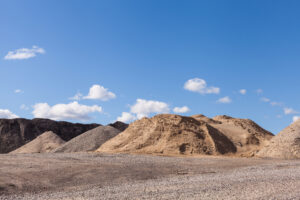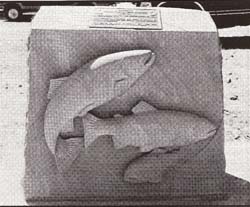
Home » Carve » Soft Stone » Stone Corner – Sandstone Jan/Feb 1997
Sandstone has been a reliable utility stone throughout the centuries. Many cities, both ancient and modem, take advantage of its fine qualities. It is easy to quarry, found throughout the world, is relatively easy to shape and carve, and resists erosion in most climates. While it is limited in colors, it is commonly uniform, compared to other stones, and therefore provides the architect with a useful building stone.

Geology
In very basic terms, sandstone is a sedimentary rock that is nothing more than cemented sand grains. If the grain size gets too large, the rock is a conglomerate; if the grains are too fme, the rock is a claystone, shale, slate or argillite. There are several types of sandstone: arkose, arenite, graywacke, orthoquartzite and protoquartzite. The classification depends on the kind of cementing agent and the percentage of quartz and feldspar sand particles. The chief types of cementation include silica (quartz, opal and chalcedony), calcite, dolomite, clay and limonite. The cementing agent can either be deposited at the same time as the sand particles or at a later date.
The sand grains themselves can be derived from any other existing rocks that are nearby, and they may be any shape, although they are commonly rounded to subrounded owing to the collisions with other particles during transportation. They may have accumulated in ancient sand dunes, on river bottoms, in the shallow portion or deltas of fresh water lakes or in a shallow marine environment. Very slowly over millions of years, the deposits of sand are compacted by overlying rock strata. The pressure and the cement cause the rock to gain strength. As a general rule, the older the rock, the higher the strength.
Because sandstone is deposited in environments where organisms live, fossils are common. For similar reasons, concretions, hard nodes with interesting shapes, are also found in sandstone. The concretions themselves are sometimes mined and their interesting shapes are objets d’art.
As a sedimentary rock, it is deposited in layers, and is commonly interbedded with shale, limestone and coal. Where the four repeat in sequences, they are called cyclothems. Where higher depositional energy is involved, the gravel or cobbles change the rock designation to conglomerate.
As a rock (as compared to a mineral), sandstone does not have a designated hardness. Its hardness ranges considerably because of the wide range of cementing agents and degrees of weathering. Caveats aside, sandstone probably ranges from 3 to 6 in hardness. There are, of course, softer sandstones; however, they would probably not hold any sculptural detail and would spall badly in the elements. The hardness of sandstone is nonnally expressed in terms of its unconfmed compressive strength; the strength obtained by compressing a cylindrical piece of the stone to its breaking point. Unconfmed compressive strengths of stone suitable for buildings and sculpture are between 5,000 and 30,000 pounds per square inch (psi). Wilkeson Sandstone is reported to be one of the strongest sandstones in the world. Sandstone weighs between 136 and 166 pounds per cubic foot.
Sandstone is most commonly brown or gray; however, white, yellow, green and red exist. Can you guess what rock type are the “brownstones” of eastern U.S. cities? Some sandstone has layers or streaks of red iron oxide, which may make it attractive for sculpture, but not desirable as a building stone.
Its most common uses worldwide are in buildings, curbstones, bridge abutments and retaining
walls, because sandstone can be quarried relatively easily to very close tolerances. It can be pulverized into sand particles to use as sandblasting material or foundry sand. The hardest sandstones have been used as grindstones and sharpening stones.
Quarrying
Sandstone is extracted in large open pit surface mines, generally from large faces of exposed rock. Because of its stratification, it naturally divides in one dimension. The somewhat horizontal bedding provides a convenient plane on wbich the rock breaks. Planes of weakness in the other two planes commonly develop during compression or tension of the earth’s crust. However, these planes of weakness may not be the correct size for building or sculptural stone. Therefore, cutting, drilling and light blasting are sometimes required to remove the stone.
In Washington State, Wilkeson, Tenino and Chuckanut sandstones have all been removed by cutting channels or slots in the rock and then drilling a row of holes aloug the bottom of the channeled rock. A row of drill holes across the back of the channeled section also separates the stone from the mountain. The width of the channels can be varied to render different thickness of slabs or blocks. Feathers and wedges can be used to bring the stones closer to the desired size. Tbe need for carbide or diamonds for the drills is governed by the strength of the cementing mineral.
The rectangular blocks of stone are then milled by gang saws and planers to a predetennined size that closely fits the fmal carved stone. Carvers of architectural stone use a multitude of models to copy.
Working Sandstone
Sandstone is chosen commonly for its uniformity of color and grain size. A unifonn block is essential for a good sculptural stone. Some of the most common flaws in sandstone that are unique to that stone are coal seams, fossils and concretions. In addition to being unsightly, the coal seams are weak and can cause the piece to split. Fossils can either be harder thau the stone or much softer; if softer, they can fall or spall out leaving a hole in the finished piece. Concretions are hard nodes within a softer rock that fonn around a small nuclear particle and bonded with a harder cement, commonly iron oxide. As with many rocks, small seemingly undetected fractures in the stone can result in the splitting of the stone after it has been worked for some time.
Sandstone can be roughed out with a diamond or carbide skill saw. A point can be used to take the shape within about l/2-inch of tbe final shape. Shaping is then accomplished with a toothed chisel, flat chisel and a cape chisel, a narrower version of a flat chisel. A “bull-nose” chisel is used to create concave surfaces. Sandstone carvers have traditionally used wooden mallets instead of iron or steel. The wooden mallets are strong enough to work sandstone and yet they reduce the noise and seem to absorb much of the energy before it reaches the hand and arm.
Smoothing of sandstone can be perfonned witb different implements, depending on the desired final effect. Initially, a carbide scraper or rasp is used, and then final polishing can be done with another piece of sandstone or with a diamond file. The latter is definitely recommended when working with Wilkeson Sandstone.
Sandstone can be either an indoor or outdoor stone, the main differentiating factor being porosity. If the stone has a high porosity, such that water can fill the voids, it is likely better indoors. Left outdoors, moisture and freeze-thaw would soon soften the surface of the sandstone and ruin any details. Look at a piece of sandstone on a building sometime and note the occasional scallop out of the stone facade. Many of the older buildings of Europe require restoration after a century or two. The most effective deterrent is periodic cleaning of the stone.
And remember! Keep your goggles and mask on. The dust is very fine grained and more than likely contains silica. Silicosis can be debilitating and even fatal.
Appreciations
Thanks to stone carver Keith Phillips of Tenino, Washington for sharing his knowledge and expertise of sandstone with us. Keith’s enthusiasm for the history of quarrying and carving of sandstone are an inspiration to all who meet him.

We need some kind of descriptive text here.